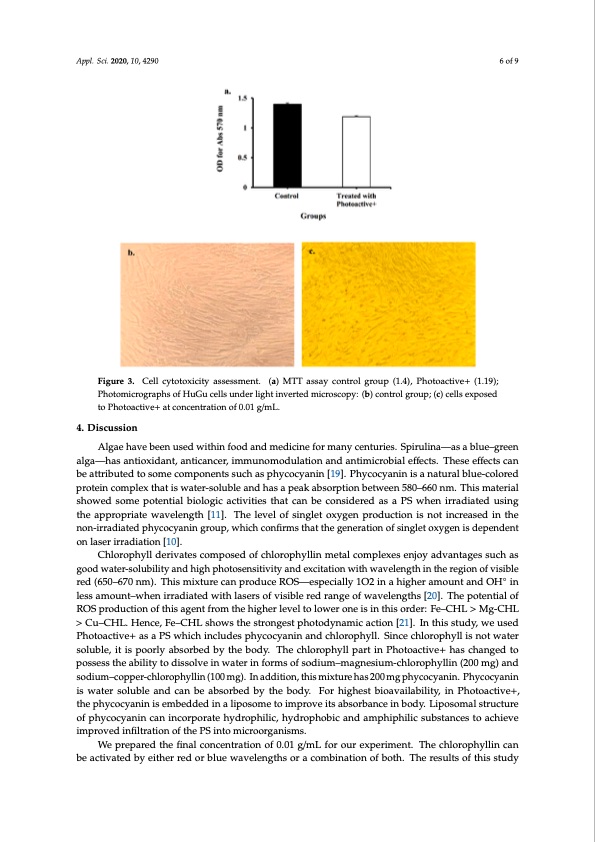
PDF Publication Title:
Text from PDF Page: 006
Appl. Sci. 2020, 10, 4290 6 of 9 Appl. Sci. 2020, 10, x 7 of 10 Figure 3. Cell cytotoxicity assessment. (a) MTT assay control group (1.4), Photoactive+ (1.19); Figure 3. Cell cytotoxicity assessment. (a) MTT assay control group (1.4), Photoactive+ (1.19); Photomicrographs of HuGu cells under light inverted microscopy: (b) control group; (c) cells exposed Photomicrographs of HuGu cells under light inverted microscopy: (b) control group; (c) cells to Photoactive+ at concentration of 0.01 g/mL. 4. Discussion 4. Discussion Algae have been used within food and medicine for many centuries. Spirulina—as a blue–green exposed to Photoactive+ at concentration of 0.01 g/mL. Algae have been used within food and medicine for many centuries. Spirulina—as a blue–green alga—has antioxidant, anticancer, immunomodulation and antimicrobial effects. These effects can alga—has antioxidant, anticancer, immunomodulation and antimicrobial effects. These effects can be attributed to some components such as phycocyanin [19]. Phycocyanin is a natural blue-colored be attributed to some components such as phycocyanin [19]. Phycocyanin is a natural blue-colored protein complex that is water-soluble and has a peak absorption between 580–660 nm. This material protein complex that is water-soluble and has a peak absorption between 580–660 nm. This material showed some potential biologic activities that can be considered as a PS when irradiated using showed some potential biologic activities that can be considered as a PS when irradiated using the the appropriate wavelength [11]. The level of singlet oxygen production is not increased in the appropriate wavelength [11]. The level of singlet oxygen production is not increased in the non-irradiated phycocyanin group, which confirms that the generation of singlet oxygen is dependent non-irradiated phycocyanin group, which confirms that the generation of singlet oxygen is on laser irradiation [10]. dependent on laser irradiation [10]. Chlorophyll derivates composed of chlorophyllin metal complexes enjoy advantages such as Chlorophyll derivates composed of chlorophyllin metal complexes enjoy advantages such as good water-solubility and high photosensitivity and excitation with wavelength in the region of visible good water-solubility and high photosensitivity and excitation with wavelength in the region◦ of red (650–670 nm). This mixture can produce ROS—especially 1O2 in a higher amount and OH in visible red (650–670 nm). This mixture can produce ROS—especially 1O2 in a higher amount and less amount–when irradiated with lasers of visible red range of wavelengths [20]. The potential of OH° in less amount–when irradiated with lasers of visible red range of wavelengths [20]. The ROS production of this agent from the higher level to lower one is in this order: Fe–CHL > Mg-CHL potential of ROS production of this agent from the higher level to lower one is in this order: Fe–CHL > Cu–CHL. Hence, Fe–CHL shows the strongest photodynamic action [21]. In this study, we used > Mg-CHL > Cu–CHL. Hence, Fe–CHL shows the strongest photodynamic action [21]. In this study, Photoactive+ as a PS which includes phycocyanin and chlorophyll. Since chlorophyll is not water we used Photoactive+ as a PS which includes phycocyanin and chlorophyll. Since chlorophyll is not soluble, it is poorly absorbed by the body. The chlorophyll part in Photoactive+ has changed to water soluble, it is poorly absorbed by the body. The chlorophyll part in Photoactive+ has changed to possess the ability to dissolve in water in forms of sodium–magnesium-chlorophyllin (200 mg) and possess the ability to dissolve in water in forms of sodium–magnesium-chlorophyllin (200 mg) and sodium–copper-chlorophyllin (100 mg). In addition, this mixture has 200 mg phycocyanin. Phycocyanin sodium–copper-chlorophyllin (100 mg). In addition, this mixture has 200 mg phycocyanin. is water soluble and can be absorbed by the body. For highest bioavailability, in Photoactive+, Phycocyanin is water soluble and can be absorbed by the body. For highest bioavailability, in the phycocyanin is embedded in a liposome to improve its absorbance in body. Liposomal structure Photoactive+, the phycocyanin is embedded in a liposome to improve its absorbance in body. of phycocyanin can incorporate hydrophilic, hydrophobic and amphiphilic substances to achieve Liposomal structure of phycocyanin can incorporate hydrophilic, hydrophobic and amphiphilic improved infiltration of the PS into microorganisms. substances to achieve improved infiltration of the PS into microorganisms. We prepared the final concentration of 0.01 g/mL for our experiment. The chlorophyllin can We prepared the final concentration of 0.01 g/mL for our experiment. The chlorophyllin can be be activated by either red or blue wavelengths or a combination of both. The results of this study activated by either red or blue wavelengths or a combination of both. The results of this study showed that aPDT with Photoactive+ and 635 nm diode laser showed the greatest reduction in thePDF Image | Antimicrobial Photodynamic Therapy Chlorophyllin–Phycocyanin

PDF Search Title:
Antimicrobial Photodynamic Therapy Chlorophyllin–PhycocyaninOriginal File Name Searched:
applsci-10-04290-v2.pdfDIY PDF Search: Google It | Yahoo | Bing
Cruise Ship Reviews | Luxury Resort | Jet | Yacht | and Travel Tech More Info
Cruising Review Topics and Articles More Info
Software based on Filemaker for the travel industry More Info
The Burgenstock Resort: Reviews on CruisingReview website... More Info
Resort Reviews: World Class resorts... More Info
The Riffelalp Resort: Reviews on CruisingReview website... More Info
| CONTACT TEL: 608-238-6001 Email: greg@cruisingreview.com | RSS | AMP |